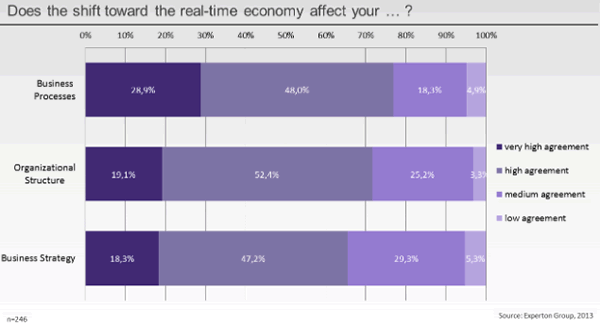 It’s probably not the first time I say this but so be it: everything is connected and it always has been. We can refer to chaos theory and the butterfly effect but let’s keep it very simple: all processes, functions and divisions are connected, as are all stakeholders in the ecosystem of our businesses, each single individual customer experience and everything we (need to) do in order to achieve better business outcomes through – connected – customer value enhancement. It’s what we call ubiquitous optimization.
It’s probably not the first time I say this but so be it: everything is connected and it always has been. We can refer to chaos theory and the butterfly effect but let’s keep it very simple: all processes, functions and divisions are connected, as are all stakeholders in the ecosystem of our businesses, each single individual customer experience and everything we (need to) do in order to achieve better business outcomes through – connected – customer value enhancement. It’s what we call ubiquitous optimization.
Today we live in a hyper-connected reality whereby the need to have a holistic and at the same time highly detailed view of how everything is connected, becomes clearer than ever. Take the many ingredients in customer experience, for instance. And how so many processes and divisions are involved in making it better, even the back office which you typically would not expect here.
Real-time is everywhere: how about now?
With this hyper-connected reality, increasing competition, the need of differentiation and innovation and, last but not least, heightened customer and stakeholder expectations, the real-time economy is accelerating – fast.
When we talk real-time economy we mean many things but obviously mainly today’s reality of digital connectivity creating the conditions for it. Real-time covers all aspects of business and society, from product development and go-to-market to HR, decision making and customer service. From a technology perspective we’re talking about fast data, artificial intelligence and the algorithm economy, big data analytics, the cloud, mobility (with mobile being the driver of the real-time consumer) and more.
The idea of the real-time economy, although gaining traction exponentially for all the obvious reasons in recent years, isn’t new. Early 2002 The Economist published an article “How about now?“. It talks about the digitization efforts at General Electric and the views of its CIO Gary Reiner. If you want to understand the essence of what we see happening in our real-time economy now, which is mentioned in the article, on the level of disruption, transformation and customer expectations, here is a prophetic quote from it, again, nearly 14 years ‘old’: “Companies will use information technology to react instantaneously to changes in their business”. And they even start to pro-act with predictive analytics to name just one example of what is coming next and already is here: a faster-than-real-time economy. Speed truly has become a competitive differentiator.
The real-time economy: instant processes in ever more of business functions
The speed of business has indeed been changing for years. While some business processes and functions are less affected by the evolutions at the basis of this changing pace, others require even more than instant processes.
Just think how the consumerization of IT often caused a gap between the consumer reality on one hand and the business reality on the other. Or about the speed of the consumer (as well as the demands for speed of what I once called Generation Now) outpaces that of most businesses. Or about how shadow IT has grown as a result of a mix of factors whereby speed and agility are two.
Instant processes require connected processes, the essence of the real-time economy. Let’s look at some drivers and effects of this real-time economy, partially based on research conducted by Experton Group, commissioned by BT and in collaboration with Cisco (disclaimer: BT Global Services is a partner).

Defining the real-time economy
The term “Real-Time Economy” is more about the on-going shift towards an economy model in which business processes and value chains are entirely digitized and connected.
Or in other words: about the possibility, infrastructures and connected processes required to work in real-time and sometimes a pro-sponsive way. So, it’s not so much about the exact time but about the real-time ability to act when and where needed. It’s about how everything and everyone is getting connected everywhere and the whole time.
The real-time economy is not a fad but very much alive in the minds of the CIO and more business-oriented CxOs. The mentioned research conducted by Experton Group, highlighted a few of the key business functions and market/customer evolutions driving the real-time economy and the need for instant processes. Among the key drivers behind the real-time phenomenon there are several factors, some organizational, some economical and some technological. But behind them there is always a (digital) business transformation/optimization and customer/stakeholder dimension.
The impact of the real-time economy on business and IT
This real-time economy has a major impact of the whole organization and its ecosystem, requiring a connected and holistic approach. Internal and external processes involving employees, customers and partners get interconnected in a much tighter way. Ultimately, the borders between internal and external might even dissaper in this integrated approach.
The Experton research clearly indicated that decision-makers see a need to let data, information and knowledge flow across the full ecosystem of the organization at much higher need. This goes for the business processes, organizational strcuture and business strategy. The most impacted by the shift toward the real-time economy are business processes. A whopping 76,9% of respondents was in high agreement or very high agreement that the shift towards the real-time economy affects their business processes.
Obviously, when we talk about processes, structures and strategy in a digital age, we inevitably encounter the challenges and opportunities in more technological dimensions as well. Just one example of the impact of/on technology: nearly sixty per cent (58.3 per cent) of executives foresee that the increasingly mobile lifestyle of employees and customers will become the number one driver within the next two years – with ubiquitous real-time access to data and applications.
Originally posted on the blog of BT Let’s Talk and adapted.
Top image purchased under license from Shutterstock

